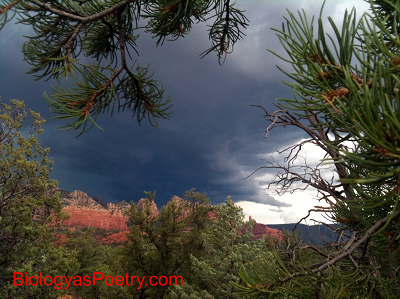∞ generated and posted on 2016.08.30 ∞
Multicellular, photoautotrophic, and land-dwelling eukaryotes.
"Multicellular" distinguishes plants (i.e., land plants) from unicellular algae; "photoautotrophic" distinguishes plants from animals and fungi; "land-dwelling" distinguishes plants from multicellular algae; and "eukaryotes" distinguishes plants from cyanobacteria (which in some cases also can be land-dwelling and also can be sort of multicellular).

Figure legend: Various plants growing along an alpine stream, Glacier National Park. Note the conifers, grasses, and various herbs, all of which are seed-bearing plants but only the latter two are also flowering plants.

Figure legend: Various plants growing in Sedona, Arizona, red rocks in the background. Conifers in the foreground.
Plants also can be described as embryophytes, where the embryo is the young sporophyte plant generation (diploid) that develops within its gametophyte parent (haploid) or, in more sophisticated plants, develops instead within the tissue of its grandparental sporophyte generation. This contrasts with various algae in which next-generation sporophytes also develop in association with parental tissue, just not enclosed within parental tissue (e.g., Laminaria). See alternation of generations.
The following video shows the Life cycle of a moss; this is a professionally produced video :
The following video describes the life cycle of a moss:
The following video shows the life cycle of ferns and flowering plant life cycle:
The following vide presents the life cycle of a flowering plant; a nicely done video: